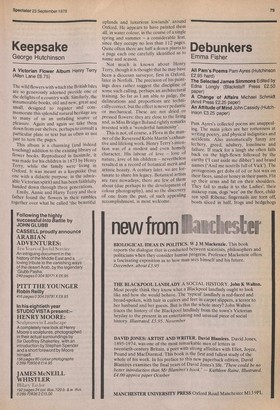Keepsake
George Hutchinson
A Victorian Flower Album Henry Terry (Allen Lane £6.75) The wild flowers with which the British Isles are so generously adorned provide one of the delights of a country walk. Similarly, the innumerable books, old and new, great and small, designed to register arid commemorate this splendid natural heritage are to many of us an unfailing source of pleasure. Again and again we take them down from our shelves, perhaps to consult a particular plate or text but as often as not Just to turn the pages.
This album is a charming (and indeed touching) addition to the existing library of flower books. Reproduced in facsimile, it was made for his children in 1873 by Henry Terry, while the family were living in Oxford. It was meant as a keepsake (but one with a didactic purpose, in the admirable Victorian spirit) and has been faithfully handed down through three generations.
Emily, Annie and Harry Terry and their father found the flowers in their rambles together over what he called 'the beautiful uplands and luxurious lowlands' around Oxford. He appears to have painted them all, in water colour, in the course of a single spring and summer – a considerable feat, since they occupy no less than 112 pages. Quite often there are half a dozen plants to a page each one carefully identified as to name and season.
Not much is known about Henry Terry, though it is thought that he may have been a diocesan surveyor, first in Oxford, later in Norfolk. The precision of his paintings does rather suggest the discipline of some such calling, perhaps an architectural training. So far as I am able to judge, the delineations and proportions are technically correct, but the effect is never pedantic or mechanical. These are not dried or pressed flowers: they are close to the living and, as Miss Bridget Boland rightly remarks invested with a 'wonderful luminosity'.
This is not, of course, a Flora in the manner of the Reverend Keble Martin's exhaustive and lifelong work. Henry Terry's intention was of a modest and even homely character. His labour of love – love of nature, love of his children – nevertheless resulted in a record of botanical merit and artistic beauty. A century later, we are fortunate to share his legacy. Botanical artists are rare nowadays; there are few of them about (due perhaps to the development of colour photography), and so the discovery of one from the past, of such appealing accomplishment, is most welcome.


































































































 Previous page
Previous page